MERCEDES-BENZ E-CLASS CABRIOLET 2010 Owners Manual
Manufacturer: MERCEDES-BENZ, Model Year: 2010, Model line: E-CLASS CABRIOLET, Model: MERCEDES-BENZ E-CLASS CABRIOLET 2010Pages: 333, PDF Size: 7.64 MB
Page 241 of 333
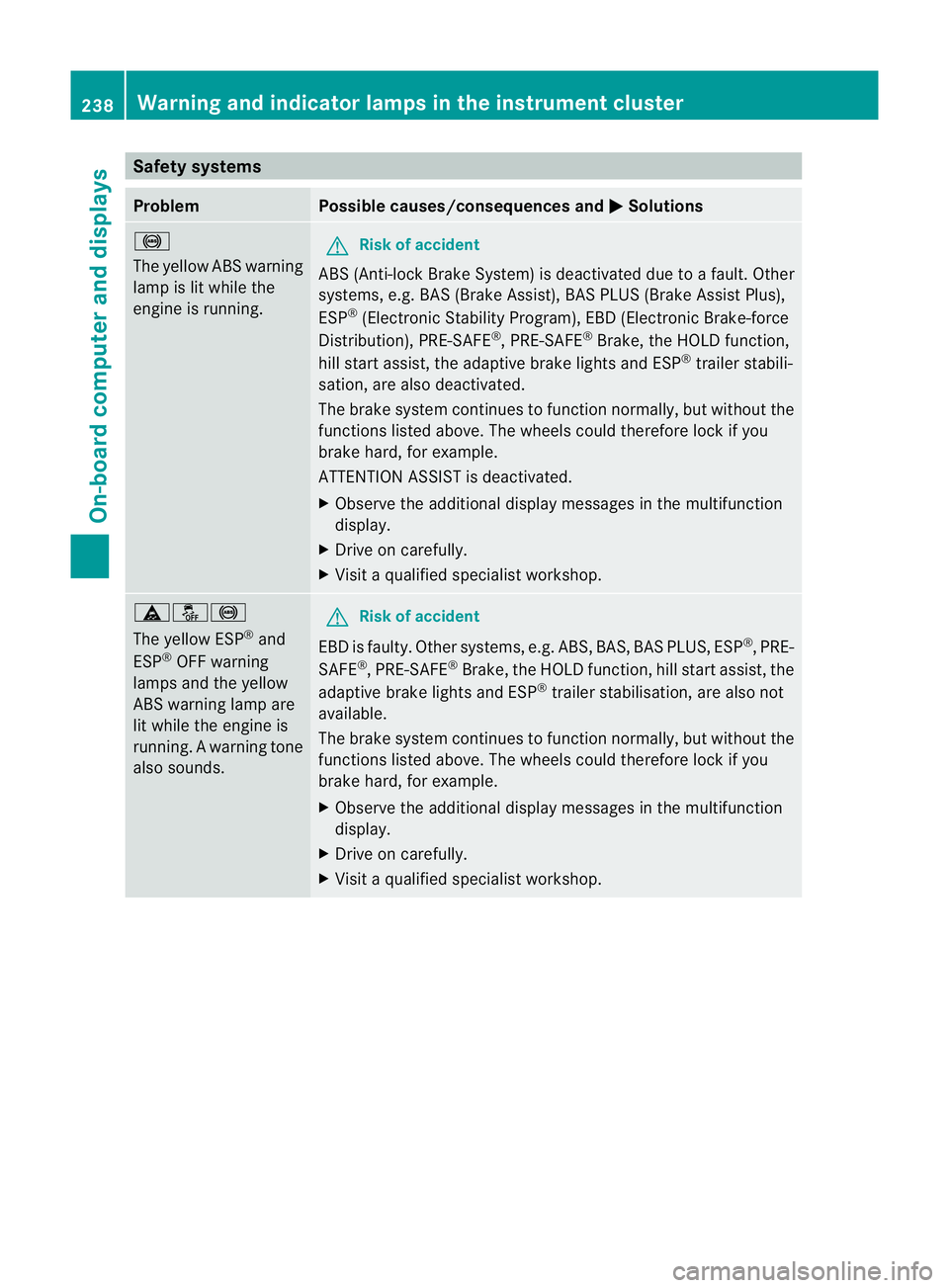
Safety systems
Problem Possible causes/consequences and
M Solutions
!
The yellow AB
Swarning
lamp is lit while the
engine is running. G
Risk of accident
ABS (Anti-lock Brake System) is deactivated due to afault. Other
systems, e.g. BAS (Brake Assist), BAS PLUS (Brake Assis tPlus),
ESP ®
(Electronic Stability Program), EBD (Electronic Brake-force
Distribution), PRE-SAFE ®
,P RE-SAFE ®
Brake, the HOLD function,
hill start assist, the adaptive brake lights and ESP ®
trailer stabili-
sation, are also deactivated.
The brake syste mcontinue stofunction normally, but without the
functions listed above. The wheel scould therefor elock if you
brake hard ,for example.
ATTENTION ASSIS Tisdeactivated.
X Observ ethe additiona ldisplay messages in the multifunction
display.
X Driv eonc arefully.
X Visit aqualified specialist workshop. äå!
The yellow ESP
®
and
ESP ®
OFF warning
lamps and the yellow
ABS warning lamp are
lit while the engine is
running. Awarning tone
also sounds. G
Risk of accident
EBD is faulty. Other systems, e.g. ABS ,BAS, BAS PLUS, ESP ®
,P RE-
SAFE ®
,P RE-SAFE ®
Brake, the HOL Dfunction ,hill start assist ,the
adaptive brake lights and ESP ®
trailer stabilisation, ar ealso not
available.
The brake system continues to func tion normally, but withou tthe
func tions listed above. The wheels coul dtherefore lock if you
brake hard, for example.
X Observ ethe additiona ldispla ymessages in the multifunction
display.
X Drive on carefully.
X Visit aqualified specialist workshop. 238
Warnin
gand indicator lam psin th einstru ment clusterOn-board computer and displays
BA 20 7ECE ÄJ 2010 /1a;1;2,e n-GB
mkalafa Version: 3.0.2.11 2010-01-26T13:03:22+01:00-Seite 238
Page 242 of 333
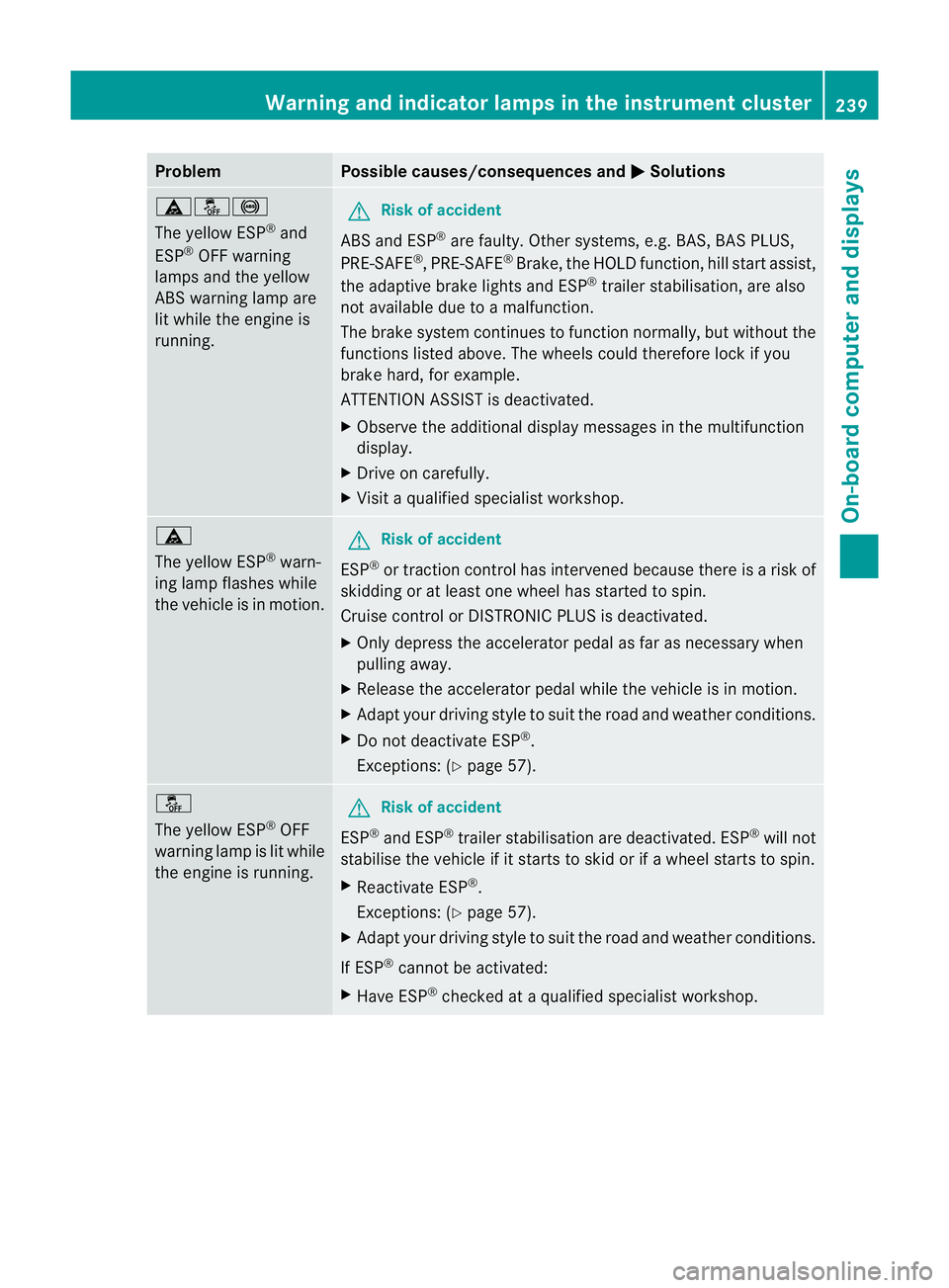
Problem Possible causes/consequences and
M Solutions
äå!
The yellow ESP
®
and
ESP ®
OFF warning
lamps and the yellow
AB Sw arning lamp are
lit while the engine is
running. G
Risk of accident
ABS and ESP ®
are faulty. Other systems, e.g. BAS ,BAS PLUS,
PRE-SAFE ®
,P RE-SAFE ®
Brake, the HOL Dfunction ,hill start assist,
th ea daptive brak elights and ESP ®
trailer stabilisation ,are also
not availabl edue to amalfunction.
The brake system continues to function normally, but without the
functions listed above. The wheels coul dtherefore lock if you
brake hard, for example.
ATTENTION ASSIST is deactivated.
X Observ ethe additional display messages in the multifunction
display.
X Drive on carefully.
X Visit aquali fieds pecialist workshop. ä
The yellow ESP
®
warn-
ing lamp flashes while
the vehicle is in motion. G
Risk of accident
ESP ®
or tra ction contro lhas intervened because ther eisarisk of
skidding or at least one wheel has started to spin.
Cruise control or DISTRONIC PLU Sisd eactivated.
X Only depress the accelerator pedal as far as necessar ywhen
pulling away.
X Release the accelerator pedal while the vehicle is in motion.
X Adap tyour drivin gstyle to suit the road and weather conditions.
X Do not deactivate ESP ®
.
Exceptions: (Y page 57). å
The yellow ESP
®
OFF
warning lamp is lit while
the engine is running. G
Risk of accident
ESP ®
and ESP ®
trailer stabilisation are deactivated .ESP ®
will not
stabilis ethe vehicle if it starts to skid or if awheel starts to spin.
X Reactivate ESP ®
.
Exceptions: (Y page 57).
X Adap tyour drivin gstyle to suit the road and weather conditio ns.
If ESP ®
cannot be activated:
X Have ESP ®
checked at aqualified specialist workshop. Warnin
gand indicator lam psin th einstru ment cluster
239On-board computer and displays
BA 207ECE ÄJ 2010 /1a;1;2,e n-GB
mkalafa Version: 3.0.2.11 2010-01-26T13:03:22+01:00-Seite 239 Z
Page 243 of 333
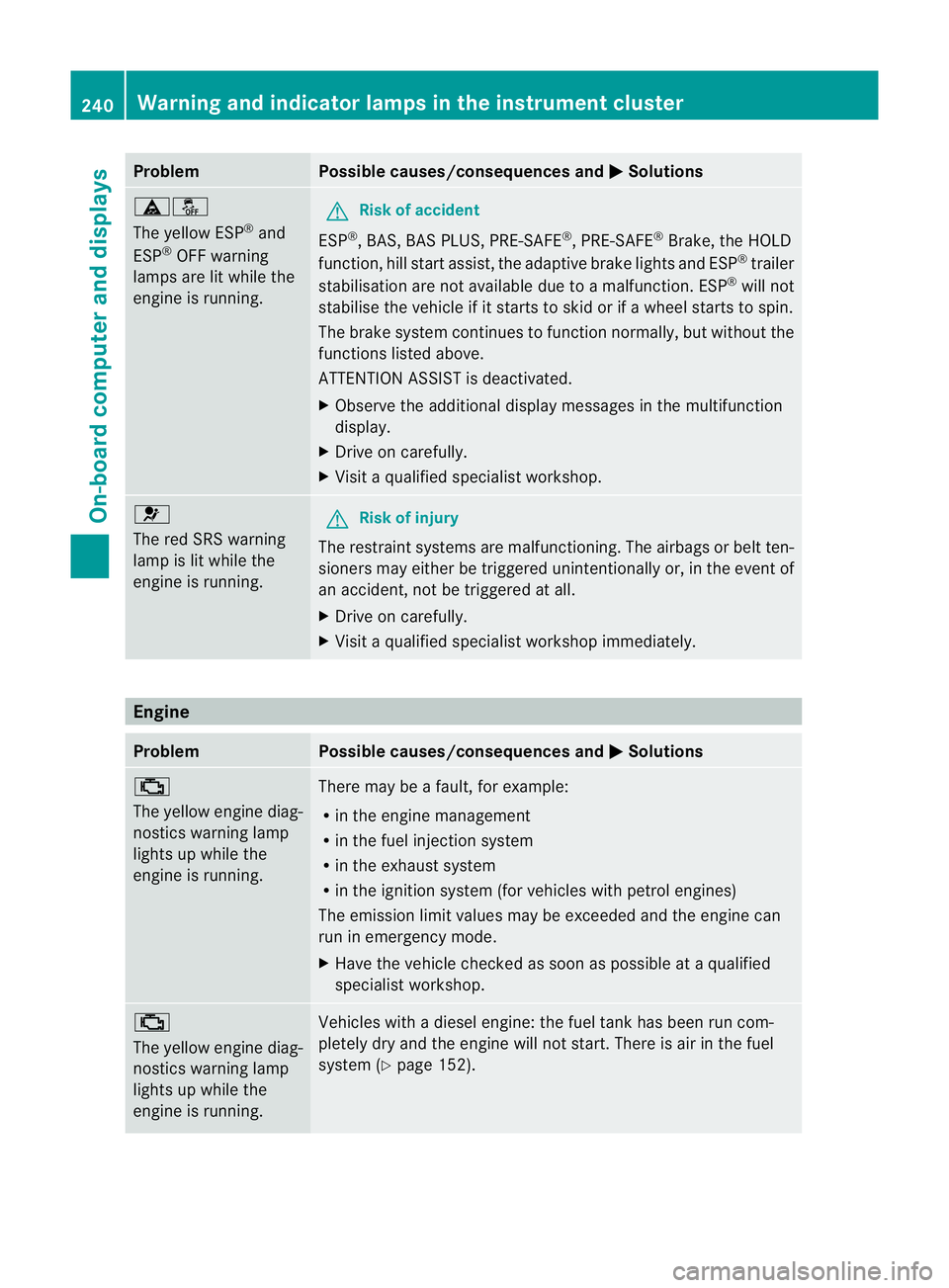
Problem Possible causes/consequences and
M Solutions
äå
The yellow ESP
®
and
ESP ®
OFF warning
lamps ar elit while the
engine is running. G
Risk of accident
ESP ®
,B AS ,BAS PLUS, PRE-SAFE ®
,P RE-SAFE ®
Brake, the HOLD
function, hill start assist, the adaptive brake lights and ESP ®
trailer
stabilisatio nare not availabl edue to amalfunction .ESP ®
will not
stabilise the vehicl eifitstarts to skid or if awheel starts to spin.
The brake system con tinues to function normally, but without the
functions listed above.
ATTENTION ASSIST is deactivated.
X Observe the additional displa ymessages in the multifunction
display.
X Drive on carefully.
X Visit aqualified specialist workshop. 6
The red SRS warning
lamp is lit while the
engine is running.
G
Risk of injury
The restraint systems are malfunctioning. The airbags or belt ten-
sioners may either be triggered unintentionally or, in the event of
an accident, not be triggered at all.
X Drive on carefully.
X Visit aqualified specialist worksho pimmediately. Engine
Problem Possible causes/consequence
sand M Solutions
;
The yellow engine diag-
nostic
swarning lamp
lights up while the
engine is running. There may be
afault, for example:
R in the engine management
R in the fuel injection system
R in the exhaust system
R in the ignition system (for vehicles with petrol engines)
The emissio nlimit values may be exceeded and the engine can
run in emergenc ymode.
X Hav ethe vehicle chec kedass oon as possible at aqualified
specialist workshop. ;
The yellow engine diag-
nostics warning lamp
lights up while the
engine is running.
Vehicles with
adiesel engine: the fuel tank has been run com-
pletely dry and the engine will not start. There is air in the fuel
system (Y page 152). 240
Warning and indicator lamp
sinthe instrument clusterOn-board computer and displays
BA 207 ECE ÄJ 2010/1a; 1; 2, en-GB
mkalafa Version: 3.0.2.11 2010-01-26T13:03:22+01:00-Seite 240
Page 244 of 333

Problem Possible causes/consequences and
M Solutions
8
The yellow reserve fuel
warnin
glamp lights up
while the engine is run-
ning. The fuel level has fallen below the reserve range.
The fuel tank must be filled at least to the reserve fuel level to
prevent impairment to the running of the engine.
X Refuel at the nearest filling station. ?
The red coolant warn-
ing lamp lights up while
the engine is running
and the coolant tem-
perature gauge is at the
start of the scale.
The temperature senso
rfor the coolant temperatur egauge is
faulty.
The coolant temperature is no longer being monitored. There is a
risk of engine damage if the coolant temperature is too high.
X Pull over and stop the vehicle safely and switch off the engine,
paying attention to road and traffic conditions. Do not continue
driving under any circumstances.
X Engage the parking brake.
X Consult aqualified specialist workshop. ?
The red coolant warn-
ing lamp comes on
while the engine is run-
ning.
The coolant level is too low.
If the coolant level is correct, the airflow to the radiator may be
blocked or the electric radiator fan may be malfunctioning.
The coolant is too hot and the engine is no longer being cooled
sufficiently.
X Pull over and stop the vehicle safely and switch off the engine,
paying attention to road and traffic conditions.
X Allow the engine and coolant to cool.
X Check the coolant level and top up the coolant (Y page 261).
Observe the warning notes.
X If the coolant needs topping up more often than usual, have the
engine coolant system checked.
X Make sure that the air suppl ytot he radiator is not blocked, e.g.
by snow, slush or ice.
X If the coolant temperature is less than 12 0†,you can con tinue
driving to the neares tqualified specialist workshop.
X Avoid subjecting the engine to heavy loads ,e.g. driving in moun-
tainous terrain, and stop-s tart driving. ?
Th
er ed coolan twarn-
ing lamp comes on
while the engine is run-
ning. Awarning tone
also sounds. The coolant temperature has exceeded 120 †. The airflow to the
radiator may be blocked or the coolant level may be too low.
The engine is not being cooled sufficiently and may be damaged.
X Pull over and stop the vehicle safely and switch off the engine,
paying attention to road and traffic conditions.
X Allow the engine and coolant to cool. Warnin
gand indicator lam psin th einstru ment cluster
241On-board computer and displays
BA 207ECE ÄJ 2010 /1a;1;2,e n-GB
mkalafa Version: 3.0.2.11 2010-01-26T13:03:22+01:00-Seite 241 Z
Page 245 of 333
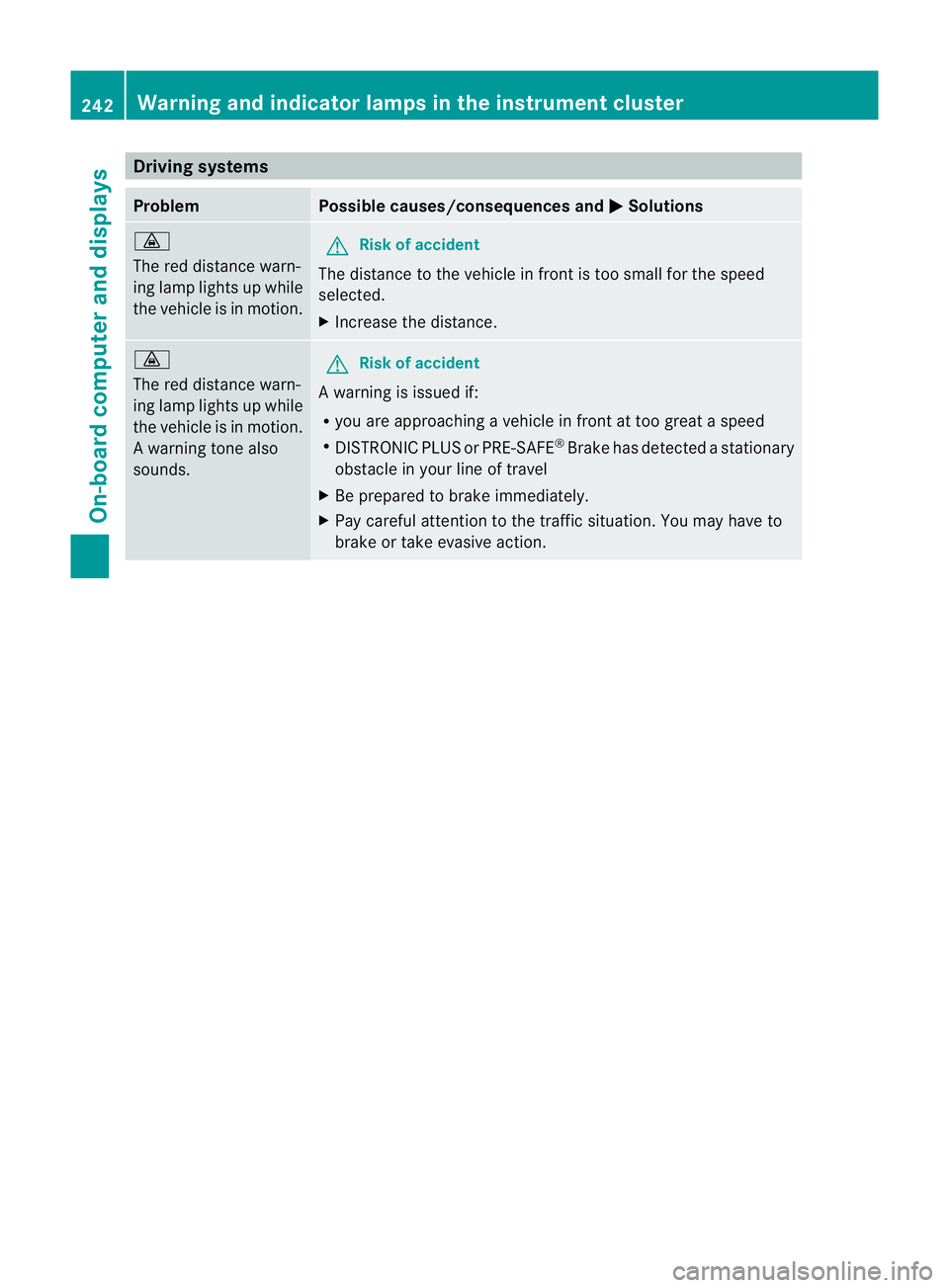
Drivin
gsystems Problem Possible causes/consequences and
M Solutions
·
Th
er ed distanc ewarn-
in gl amp lights up while
th ev ehicle is in motion. G
Risk of acc
ident
The distanc etothe vehicle in frontistoo smal lfor the speed
selected.
X Increase the distance. ·
The red distance warn-
ing lam
plights up while
the vehicle is in motion.
Aw arning ton ealso
sounds. G
Ris
kofa ccident
Aw arning is issued if:
R you are approaching avehicle in fron tattoo grea taspeed
R DIST RONIC PLUS or PRE-SAFE ®
Brake has detected astationary
obstacle in your line of travel
X Be prepared to brake immediately.
X Pay careful attention to the traffic situation. You may have to
brake or take evasive action. 242
Warning and indicator lamps in the instrument clusterOn-board computer and displays
BA 207 ECE ÄJ 2010
/1a; 1; 2, en-GB
mkalafa Version: 3.0.2.11 2010-01-26T13:03:22+01:00 -Seite 242
Page 246 of 333
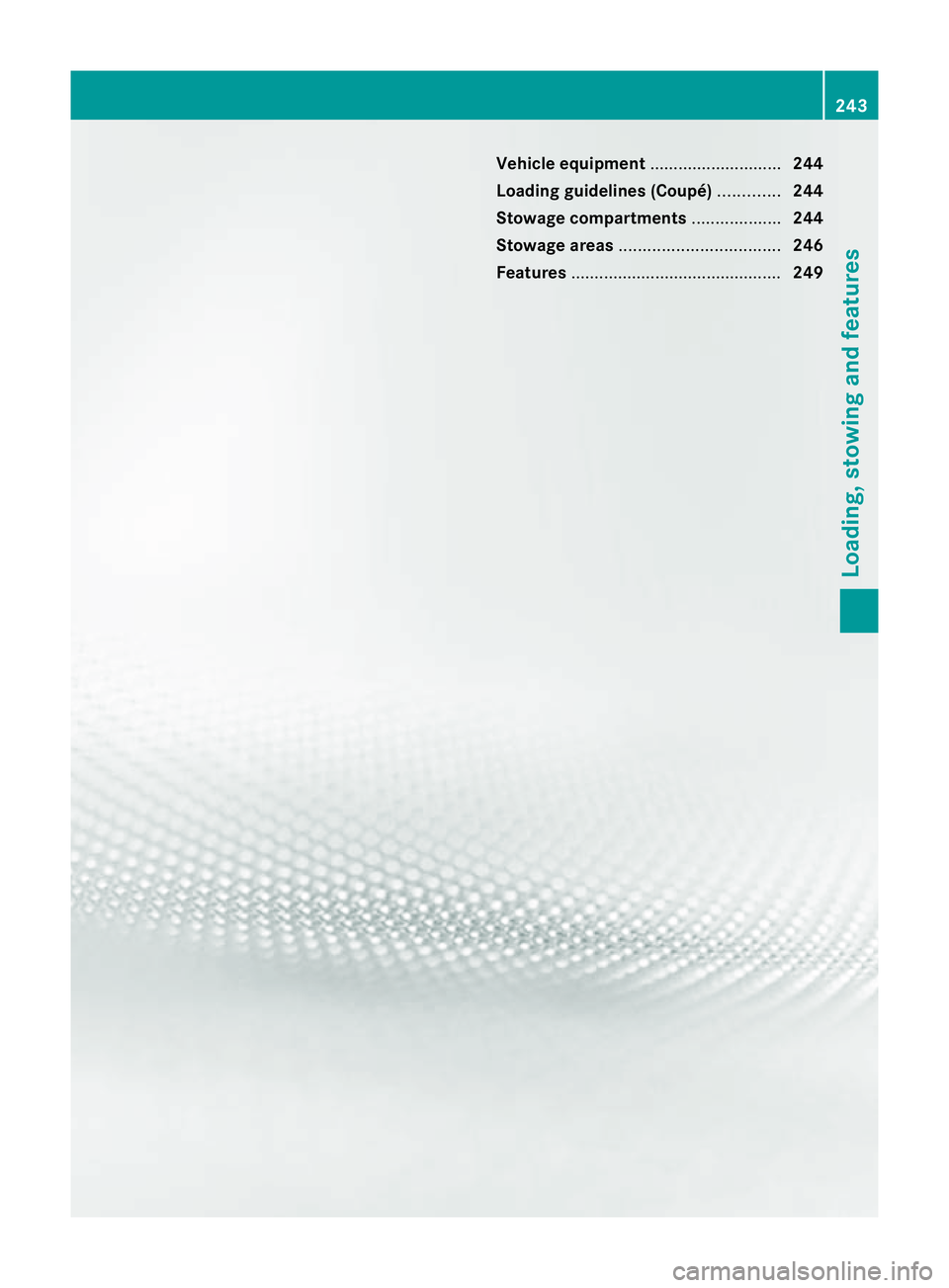
Vehicl
eequipment ............................ 244
Loading guidelines (Coupé) .............244
Stowage comp artments ................... 244
Stowage are as.................................. 246
Features ............................................. 249 243Loading, stowing and fea
tures
BA 207ECE ÄJ 2010/1a; 1; 2, en-GB
mkalafa Version:3.0.2.11
2010-01-26T13:03:22+01:0
0-Seite 243
Page 247 of 333

Vehicl
eequipment
i Thismanua ldesc ribe sallthe standard
and optional equipment of your vehicle
which wa savailable at th etime of pur-
chase. Countr y-specif ic differences are
possible. Bear in mind tha tyour vehicle
ma ynot featur eall function sdescribed
here. Loading guidelines (Coupé)
G
Risk of inju
ry
Secure and positio nthe load as described in
the loadin gguidelines.
Otherwise, vehicle occupant scould
be injured by the load being thr own around in
the even tofsharpbraking, asudden change
in direction or an accident.
You will find further information in the "Secur-
ing aload" section.
Even if you follow all the loadin gguidelines,
the load will increase the risk of injur yinthe
even tofa naccide nt. G
Risk of poisoning
Keep the boo tlid closed while the vehicle is
in operation .Otherwi se,y ou could be pois-
one dbye xhaust fumes enterin gthe vehicle.
Th eh andling character istics of aladen vehi-
cl ea re dependent on the distributio nofthe
load withi nthe vehicle. For this reason, you
should observe the followin gnotes when
transpor ting aload:
R When transpor ting aload, never exceed the
maximum permissible gross vehicle weight
or the permissible axle loads for the vehicle
(includin goccupants).
R Position heavy loads as far forward saspos-
sible and as low down in the boot as pos-
sible.
R The load must not protrude abov ethe
upper edge of the seat backrests. R
always plac ethe load against the rea ror
front seat backrests .Make sure that the
seat backrests are securely locked into
place.
R Always place the load behind unoccupied
seats if possible.
R Secure the load with sufficiently stron gand
wear-resistant lashing material. Pad sharp
edges for protection.
i Load restraints are available at any quali-
fied specialis tworkshop, e.g. aMercedes-
Benz Servic eCentre. Stowage compartments
Important safety notes
G
Risk of injury
The stowage compartments must be closed
when item sare store dinthem. Luggage nets
ar en ot designed to secur eheavy item sof
luggage.
You or other vehicle occupant scould be
injure dbyo bjectsbeing thrown around if you:
R brak esharply
R change direction suddenly
R arei nvolved in an accident
Sharp-edge dand fragile object smust not be
placed in the luggag enet.
Do not place hard object sinthe ma ppockets.
Object smust not protrude from the map
pockets. Front stowage compartments
Glove compartment i
Depending on the vehicle equipment, an
AUX IN connection or aMedia In terface is
installed in the glove compartment. A
Media Interface is auniversal interface for
mobil eaudi od evices, such as iPods ®
or
US Bd evices; see the separate Audio or
COMAN DAPS operating instructions. 244
Stowage compa
rtmentsLoading, stowing and features
BA 207ECE ÄJ 2010 /1a;1;2,e n-GB
mkalafa Version: 3.0.2.11 2010-01-26T13:03:22+01:00-Seite 244
Page 248 of 333
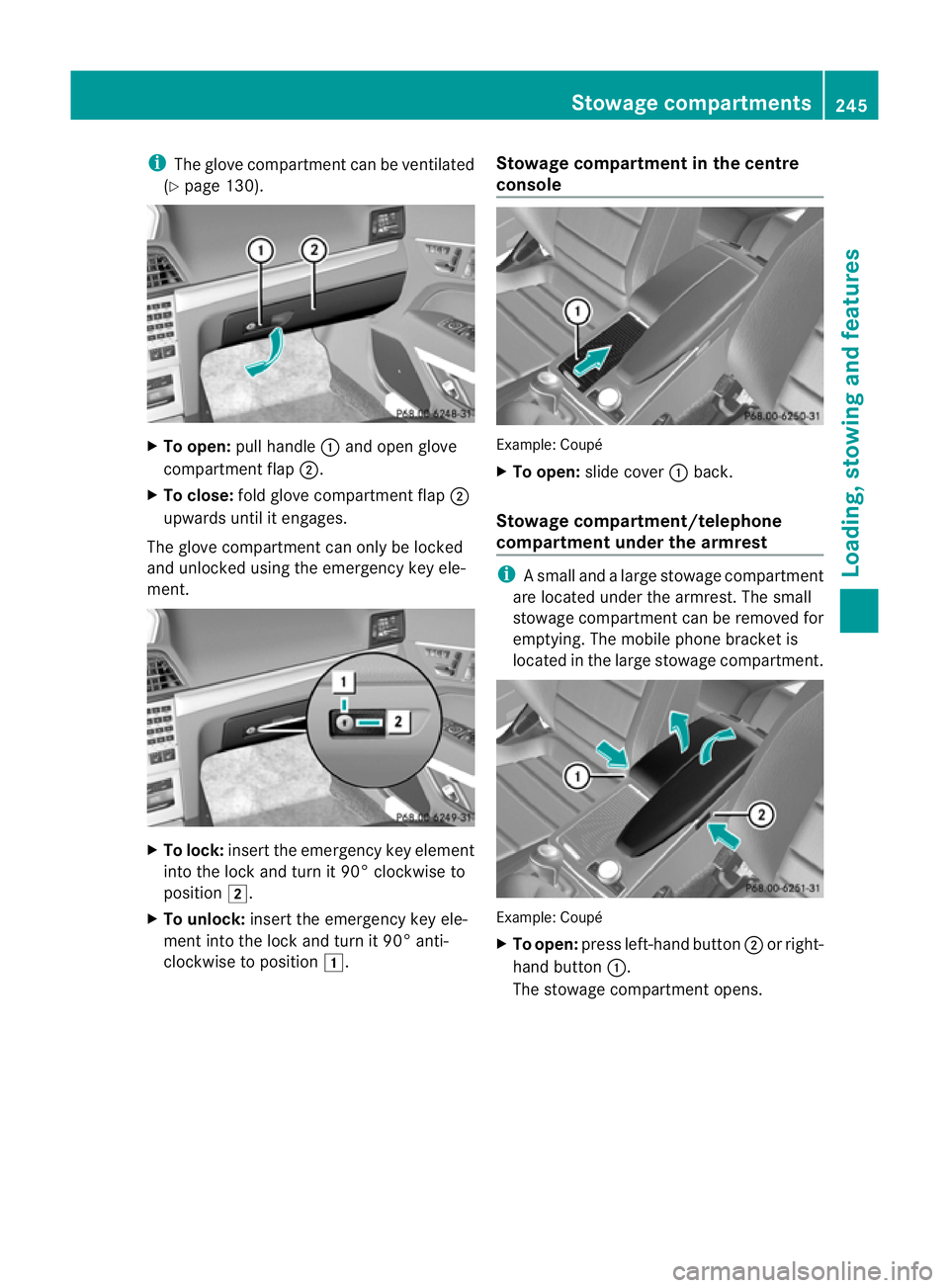
i
The glove compar tment can be ventilated
(Y pag e130). X
To open: pullhandle :and open glove
compartment flap ;.
X To close: fold glove compartment flap ;
upwards until it engages.
The glove compartment can only be locked
and unlocked using the emergenc ykey ele-
men t. X
To lock: insert the emergenc ykey element
into the lock and tur nit90° clockwise to
position 2.
X To unlock: insert the emergency key ele-
ment into the lock and turn it 90° anti-
clockwise to position 1. Stowage compartmen
tinthe centre
conso le Example: Coupé
X
To open: slide cover :back.
Stowag ecompartment/telephone
compartment under the armrest i
Asmall and alarg estowage compartment
are located under the armrest. The small
stow agecompartment can be removed for
empty ing. The mobi lephone bracket is
located in the large stowage compartment. Example: Coupé
X
To open: press left-hand button ;or right-
hand button :.
The stowage compartment opens. Stowage compa
rtments
245Loading, stowing and features
BA 207 ECE ÄJ 2010/1a; 1; 2, en-GB
mkalafa Version: 3.0.2.11 2010-01-26T13:03:22+01:00-Seite 245 Z
Page 249 of 333
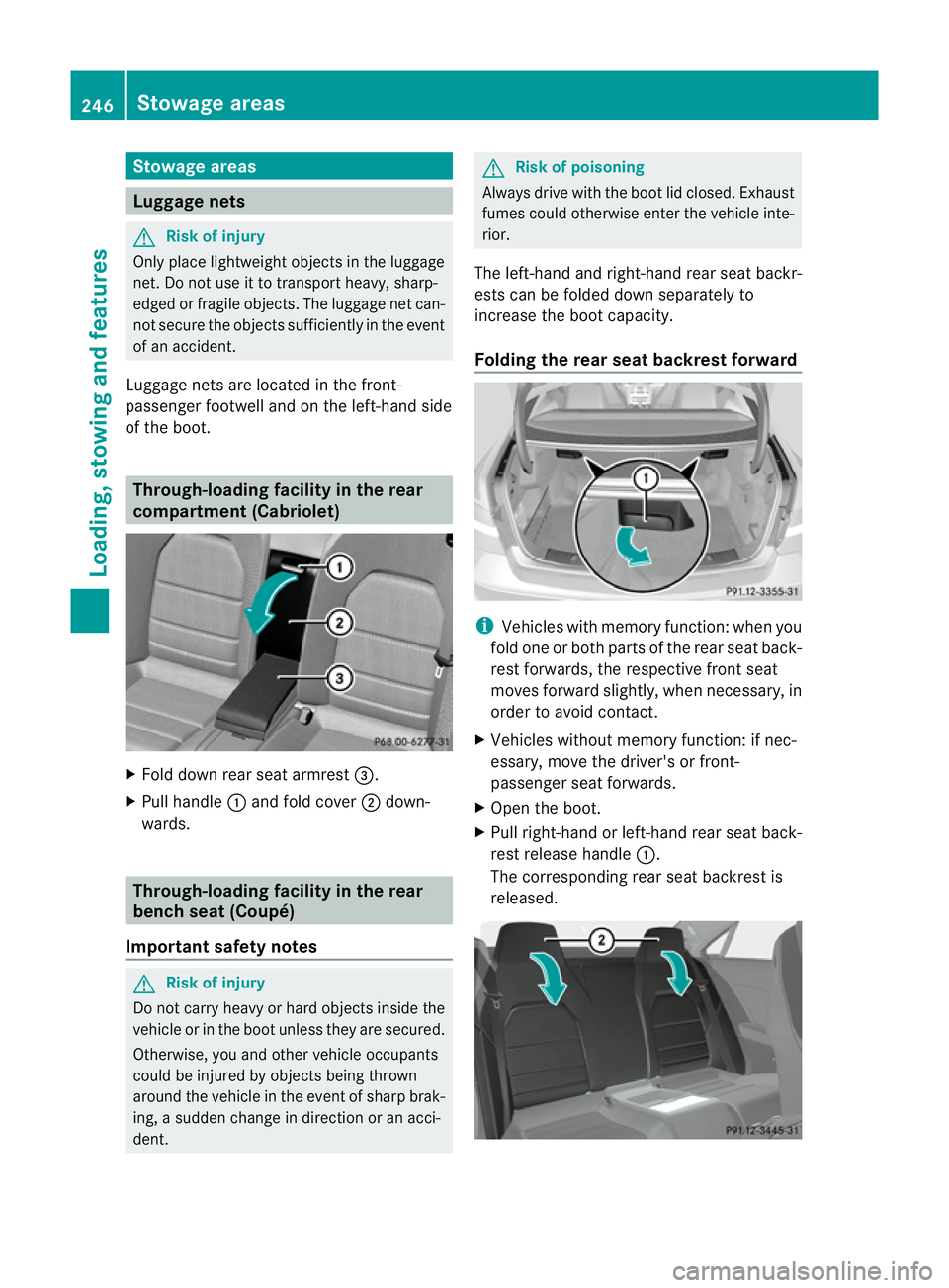
Stowage areas
Luggage nets
G
Ris
kofi njury
Only place lightweight object sinthe luggage
net .Don ot use it to transpor theavy ,sharp-
edged or fragile objec ts.T he luggage net can-
not secur ethe objec tssufficiently in the event
of an accident.
Luggage net sare locate dinthe front-
passenger footwell and on the left-hand side
of the boot. Th
rough- loading facility in the rear
compartment (Cabriolet) X
Fold down rear seat armrest =.
X Pull handle :and fold cover ;down-
wards. Through-loading facility in the rear
bench seat (Coupé)
Impor tantsafety notes G
Ris
kofi njury
Do not carry heavy or hard object sinsid ethe
vehicle or in the boot unless they ar esecured.
Otherwise, you and other vehicle occupants
could be injured by object sbeing thrown
around the vehicle in the event of sharp brak-
ing, asudden change in direction or an acci-
dent. G
Risk of poisoning
Always drive with the boot lid closed .Exhaust
fumes could otherwise enter the vehicle inte-
rior.
The left-hand and right-hand rear seat backr-
ests can be folded down separately to
increase the boot capacity.
Folding the rear seat backrest forward i
Vehicles with memory function: when you
fold one or both parts of the rear seat back-
rest forwards, the respective front seat
moves forwar dslightly, when necessary, in
order to avoid contact.
X Vehicles without memor yfunction: if nec-
essary, move the driver' sorfront-
passenger seat forwards.
X Open th eboot.
X Pull right-han dorleft-hand rear seat back-
rest release handle :.
The corresponding rear seat backrest is
released. 246
Stowage areasLoading, stowing and features
BA 20
7ECE ÄJ 2010 /1a;1;2,e n-GB
mkalafa Version: 3.0.2.11 2010-01-26T13:03:22+01:00-Seite 246
Page 250 of 333
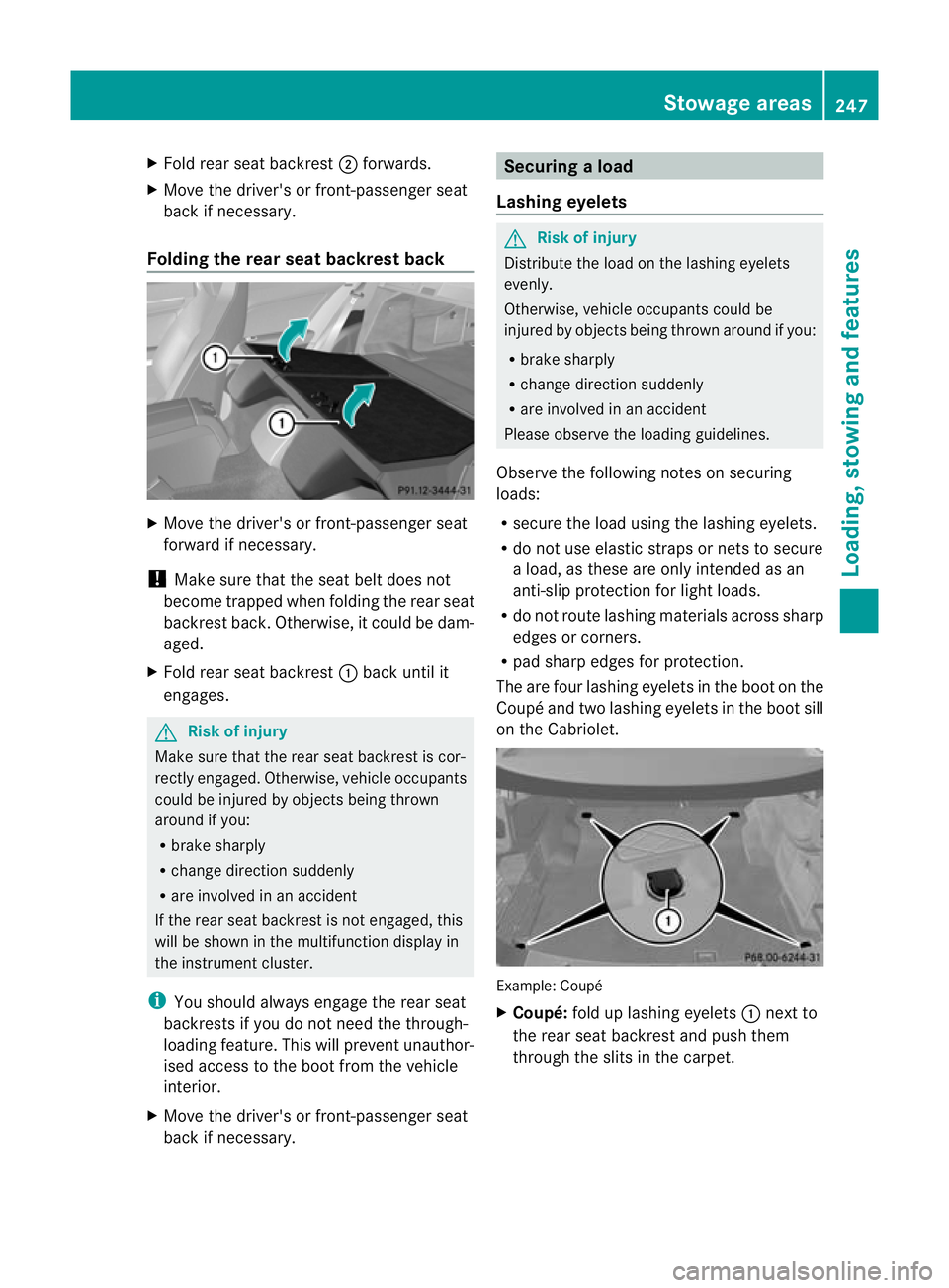
X
Fold rea rseat back rest ; forwards.
X Move the driver's or front-passenger seat
bac kifn ecessary.
Folding the rea rseat backrest back X
Move the driver's or front-passenger seat
forwar difnecessary.
! Make sure that the seat belt does not
becom etrappe dwhen folding the rea rseat
back rest back. Otherwise, it could be dam-
aged.
X Fold rea rseat back rest : bac kuntil it
engages. G
Risk of injury
Make sure that the rear seat backrest is cor-
rectly engaged. Othe rwise, vehicle occupants
could be injured by objects being thrown
around if you:
R brake sharply
R change direction suddenly
R are involved in an accident
If the rear seat backrest is not engaged, this
will be shown in the multifunction display in
the instrument cluster.
i You should always engage the rear seat
backrests if you do not need the through-
loading feature. This will preven tunauthor-
ised access to the boot from the vehicle
interior.
X Mov ethe driver' sorfront-passenger se at
back if necessary. Securin
gaload
Lashing eyelets G
Ris
kofi njury
Distribut ethe load on thelashing eyelets
evenly.
Otherwise, vehicle occupant scould be
injure dbyo bjectsbein gthrown ar oundify ou:
R bra kesharply
R change directio nsuddenly
R are involved in an accident
Please observ ethe loading guidelines.
Observ ethe following notes on securing
loads:
R secur ethe load using the la shingeyelets.
R do not use elasti cstraps or nets to secure
al oad, as these ar eonly intended as an
anti-slip protection for light loads.
R do not route lashing materials across sharp
edges or corners.
R pad sharp edges for protection.
The are four lashing eyelets in the boo tonthe
Coupé and two lashin geyelets in the boo tsill
on the Cabriolet. Example: Coupé
X
Coupé: fold up lashing eyelets :next to
the rear seat backrest and push them
through the slits in the carpet. Stowage areas
247Loading, stowin gand features
BA 20 7ECE ÄJ 2010/1a; 1; 2, en-GB
mkalafa Version: 3.0.2.11 2010-01-26T13:03:22+01:00-Seite 247 Z